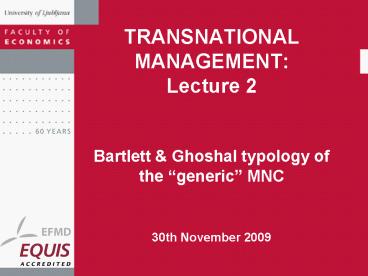TRANSNATIONAL MANAGEMENT: Lecture 2 PowerPoint PPT Presentation
1 / 33
Title: TRANSNATIONAL MANAGEMENT: Lecture 2
1
TRANSNATIONAL MANAGEMENTLecture 2
- Bartlett Ghoshal typology of the generic MNC
- 30th November 2009
2
Todays course agenda
- Looking at the brief history of the MNC
- What is actually a MNC?
- The study of MNCs through time
- The 3 strategic goals of the generic MNC
- The Bartlett Ghoshal typology
- Case example
3
1. A brief history of the MNC
- First mentioned MNC activity Birth of the
Multinational (1999) by Moore Lewis - Long before their (Assyrian) armies marched up
and down the Tigris and Euphrates to terrorize
the ancient world, groups of talented Assyrian
traders peacefully took up residence in foreign
countries hundreds of kilometers away from home,
being welcomed by the princes of Babylon, Aram
and even distant Anatolia... the business
operated by the ancient Assyrian colonists
constituted the first genuine multinational
enterprises in recorded history (Moore, Lewis,
1999, pp. 27). - The first contemporary MNC The British East
India Company (1600 AD) The Dutch East India
Company (1602 AD) - both imperial corporations
with monopoly power on trading with India and Asia
4
The British East India Company
5
2. What is actually a MNC?
6
The distinguishing characteristics of MNCs
- Differences in social, political, economic, legal
and technological contexts not WHERE, but HOW
it takes place! - The drivers of difference (from lecture 1)
- Key distinguishing characteristics
- Issue of sovereignty (role of the national state)
political risk - Difference in competitive strategy (single vs.
multiple markets) - Prevailing level of complexity and coordination
- Unit of measure for performance (single vs.
multiple units) - Organizational structure and management systems
(domestic product and functional diversity MNC
geographical diversity)
7
Some definitions of MNCs
- Bartlett Ghoshal substantial FDI and active
management - OECD UNCTSC an enterprise that engages in
foreign direct investments (FDIs) and owns or
controls value-adding activities in more than one
country - Hymer (1979) The multinational corporation has
become the dominant organizational form of modern
capitalism. It now commands tremendous influence
and power over the economic, social, political,
and cultural lives of many nations and people - Zanfei (2005) ultimate carriers of progress and
development opportunities, or as the extreme
expression of predatory behavior, based on the
systematic appropriation of rents - Morgan, Kristensen Whitley (2003)
trasnanational communities and spaces of social
relationships
8
Impact of MNCs on the world economy
- There are today some 70,000 MNCs
- With over 700,000 units (affiliates)
- Top 500 MNCs account for almost 70 of world
trade - Lead agents of the globalization process
- Industries some examples
- 85 of the global automobile industry
- 70 of the computer industry
- 35 of the toothpaste industry
- 65 of global soft drinks industry
- Etc
9
What about size?
- We have seen the emergence of the so called SME
type MNCs - Powered by new technology advances
- Liberalization and integration forces
10
You dont have to be big.
11
to be better!
12
A look at a SME type of MNC
13
3. Study of MNCs trough time
14
Development of MNC literature
15
4. Three strategic goals of the MNC
3 strategic goals of the generic MNC
GLOBAL EFFICIENCY in existing activities
INTERNATIONAL FLEXIBLITY / LOCAL RESPONSIVENESS
WORLD-WIDE LEARNING from diversity exposure
16
I. Global efficiency
- Efficiency relation between value of INPUTS and
OUTPUTS - Reaching
- Economies of scale (standardization)
- Economies of scope
- Economies of skill
- Modularity
17
II. Local responsiveness
- Adaptation issues (standardization vs.
adaptation) - Ability to detect changes in the environment,
which may represent risks or opportunities - Better risk management
- Speed and adaptability
- Building competitive advantage on diversity
- Flexibility vs. efficiency
18
III. World-wide learning
- Understanding local responsiveness provides
opportunity for learning - Not just learning but information flow and
knowledge transfer - Learning from mistakes and best practices of
others - Being able to use local specifics and differences
is a competitive advantage - Companies must develop appropriate mechanisms and
organizational structures, which facilitate
learning and knowledge transfer
19
Example How do companies learn?
In their internal magazine, 3M has a special
Uuups section, where they discuss failed
projects. A special adhesive, that is used today
in Post-its was one of them and was adopted by
another employee in the company!
20
Example Google
http//www.youtube.com/watch?vb59Jc3n0xHQfeature
related
21
Example The iPod story
22
5. The Bartlett Ghoshal typology
- 1989 Bartlett Ghoshal ? Managing across
borders the transnational solution (one of the
50 most influential economic and business books
of the 20th century) - Any internationally active company must fulfill 3
important strategic goals - GLOBAL EFFICIENCY in existing activities
- INTERNATIONAL FLEXIBILITY and LOCAL
RESPONSIVENESS (appropriate management of risks
and opportunities) - WORLD-WIDE LEARNING thought its exposure to local
contexts - 4 company mentalities
- INTERNATIONAL COMPANY
- MULTINATIONAL COMPANY
- GLOBAL COMPANY
- TRANSNATIONAL COMPANY (a revolutionary new form
NEW MANAGEMENT MENTALITY!)
23
Mentality focus
24
I. Global strategy - pros
25
(No Transcript)
26
I. Global strategy - cons
27
Ideal strategy?
28
The other strategies (mentalities)
29
Understanding transnationality
- An idealized concept
- A new revolutionary form of organization
mentality - Each company has its degree of transnationality
30
6. Company case Danfoss (Trata)
- A globally present family company from Denmark
- Denmarks biggest industrial organization
- Some 28,000 employees world-wide
- Over 70 companies in 25 countries and with over
115 sales organizations - Over 75-year long tradition
31
Danfoss organization structure
32
Example World-wide learning
http//www.youtube.com/watch?vlLU2LDqPlWM
http//www.youtube.com/watch?v2GAGFHt4zNEfeature
related
33
By next time
- Please read the Danfoss Trata case by Wednesday
- Be prepared to discuss it
- Look for clues on its transnational mentality?
- Global efficiency
- Local responsiveness
- World-wide learning

